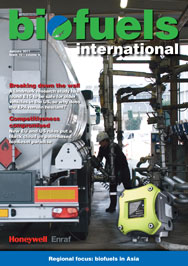
Volume 4, Issue 10
Published: December 23, 2010
Breaking down the wall
Register or Log In to view this "Free Article"On 13 October 2010 the US Environmental Protection Agency (EPA) formally began a regulatory process that could pave the way towards the commercialisation of a 15% blend of ethanol (E15) in standard pump...
Higher quality without the added cost
On 1 January 2012 the current prestandard DIN 51605 concerning fuels from rapeseed oils will be changed into a binding DIN standard, containing much lower limit values of phosphor, calcium and magnesium....
The bigger the better?
The Netherlands is frequently referred to as the gateway to Europe and is a key trading area for the petrochemical industry. The Port of Rotterdam has an annual throughput of around 400 million tonnes...
The road to recovery
From highs of over $140 (€106) per barrel in mid-2008, crude oil crashed to below $40 per barrel in early 2009. Subsequently the price has shown a remarkable recovery and could now rise to $90 or higher...
Three is the magic number
For some time China has been home to the third-largest oil refi ner in the world, Sinopec, and in September 2010 it became the world’s third-largest ethanol producer behind Brazil and the US. Getting...
Government support grows in China
While new government initiatives to expand biofuel use in China are still at an early stage of implementation it appears that Beijing is giving greater support to develop biodiesel production, which has...
India’s mandate: assessing its impact
The government approved the National Policy on Biofuels on 24 December 2009, which proposes a target of 20% blending of biodiesel and bioethanol by 2017. The government’s current target of 5% blending...
Competitiveness compromised
The United Nations announced on 11 December that the Convention on Climate Change 16th Conference in Cancun had succeeded in negotiating new benefi ts for a global deforestation prevention programme. Industrialised,...
The energy cornerstone
The US is the world’s largest corn-ethanol producer. In 2010 ethanol processors will use 4.4 billion bushels of corn compared to last year’s total of 3.7 billion. And for the fi rst time co-products...
Ethanol evangelist
Despite its size and prominence within the renewable fuels sector – and a recent coast-to-coast brand-building television advertising campaign – Poet is hardly a household name in North America. But...
Efficient mixing
Producing ethanol is a complex and multistage process and one of the decisions an operator faces is whether to use a top-entry or sideentry agitator system. When a clearly pronounced homogenisation is...
Eleven algae trends to watch in 2011
1 Emerging markets growth US and EU-based algae producers and licensors of technology are increasingly looking to the emerging markets in Latin America, Asia, Africa and the Middle East for faster economic...
Advances in filtration technologies
Throughout the debate on whether E15 blends should be permitted, signifi cant research efforts have been made into the impact of the biofuel on vehicle engines. With such scrutiny it is more important...
Membrane technology
Membrane fi ltration technology shows promise to improve second generation cellulosic ethanol processes. Producers seek to optimise fuel recovery and secondary products from the feedstock. In addition,...
Half the trouble
Vinasse, a residual substance left after sugarcane alcohol distillation, represents a major environmental problem for the ethanol industry. It can be used as a fertiliser, something Brazil has done since...
Yeasts yield results
In ethanol economics it is no secret that the feedstock results in roughly 80% of the plant’s costs. Most emphasis is placed on the sugar or the starchy biomass, yet down the cost scale few pay attention...










